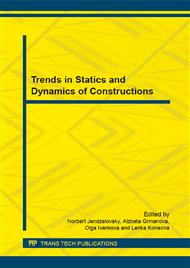[1]
CEB-FIB, Model Code for Concrete Structures 2010, fib - International Federation for Structural Concrete, (2013).
DOI: 10.35789/fib.bull.0002
Google Scholar
[2]
ACI Committee 318, Building code requirements for structural concrete and commentary, American Concrete Institute, United State America, (2011).
Google Scholar
[3]
CSA Standard A23. 3, Design of concrete structures, Canadian Standard Association, (2004).
Google Scholar
[4]
B. Wieczorek, Influence of the location of the column on the load capacity of a slab-column connection for the inner column after punching, Procedia Engineering, Vol. 57, (2013).
DOI: 10.1016/j.proeng.2013.04.158
Google Scholar
[5]
B. Wieczorek, Experimental tests for the analysis of a load-bearing capacity of an internal slab-column connection after its punching at various positions of the column, Advanced Materials Research, Vol. 969, (2014).
DOI: 10.4028/www.scientific.net/amr.969.169
Google Scholar
[6]
M. Wieczorek, Influence of amount and arrangement of reinforcement on the mechanism of destruction of the corner part of a slab-column structure, Procedia Engineering, Vol. 57, (2013).
DOI: 10.1016/j.proeng.2013.04.159
Google Scholar
[7]
M. Wieczorek, Investigations concerning the corner part of the reinforced concrete structure in the emergency of removing the corner support, Procedia Engineering, Vol. 65, (2013).
DOI: 10.1016/j.proeng.2013.09.023
Google Scholar
[8]
M. Wieczorek, Comparison experimental tests of behavior of the slab-column structure after removal of the corner support with the simplified models describing the mechanism of destruction, Advanced Materials Research, Vol. 969, (2014).
DOI: 10.4028/www.scientific.net/amr.969.78
Google Scholar
[9]
B. Wieczorek, Numerical modelling of the destruction of reinforcement bars in the supporting zone of the column connection, 20th International conference Engineering mechanics, Svratka, Czech Republic, May 12-15, (2014).
Google Scholar
[10]
M. Wieczorek, Numerical analysis of the deformation of the corner part of slab-column structures, 20th International conference Engineering mechanics, Svratka, Czech Republic, May 12-15, (2014).
Google Scholar
[11]
M. Wieczorek, Numerical analysis of narrow single-span, gravitationally loaded concrete slabs reinforced by steel with a mean ductility, 20th International conference Engineering mechanics, Svratka, Czech Republic, May 12-15, (2014).
Google Scholar
[12]
Report of the research grant Innovating means and effective methods of improving the safety and durability of building structures and the infrastructure of transport in the strategy of reconciled development, POIG. 01. 01. 02-10-106 (not published).
Google Scholar
[13]
PN-EN 1992-1-1: 2004/AC, Eurocode 2, Design of concrete structures - Part 1-1: General rules and rules for buildings, European Standard, (2010).
DOI: 10.3403/03178016
Google Scholar
[14]
J. Cervenka, V. K. Papanikolaou, Three dimensional combined fracture – plastic material model for concrete. Int. J. Plasticity, 2008, 24 (12).
DOI: 10.1016/j.ijplas.2008.01.004
Google Scholar
[15]
O. Sucharda, J. Brozovsky, D. Mikolasek, Numerical modelling and bearing capacity of reinforced concrete beams, Key Engineering Materials, Vol. 577-578, (2014).
DOI: 10.4028/www.scientific.net/kem.577-578.281
Google Scholar
[16]
PN-EN 1991-1-1: 2006/AC, Eurocode 1, Actions on structures - Part 1-1: General actions – Densities, self-weight, imposed loads for buildings, European Standard, (2010).
DOI: 10.3403/30396138
Google Scholar
[17]
PN-EN 1991-1-7: 2006/AC, Eurocode 1, Actions on structures - Part 1-7: General actions – Accidental actions, European Standard, (2010).
DOI: 10.1002/9783433601570.oth1
Google Scholar


